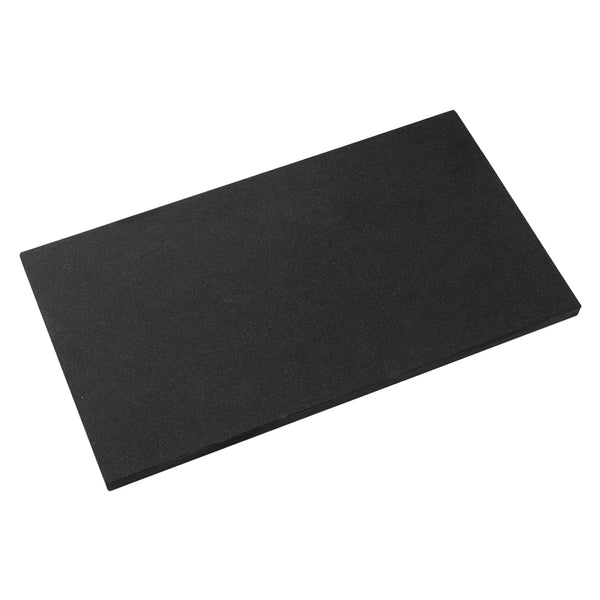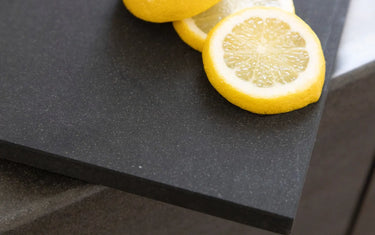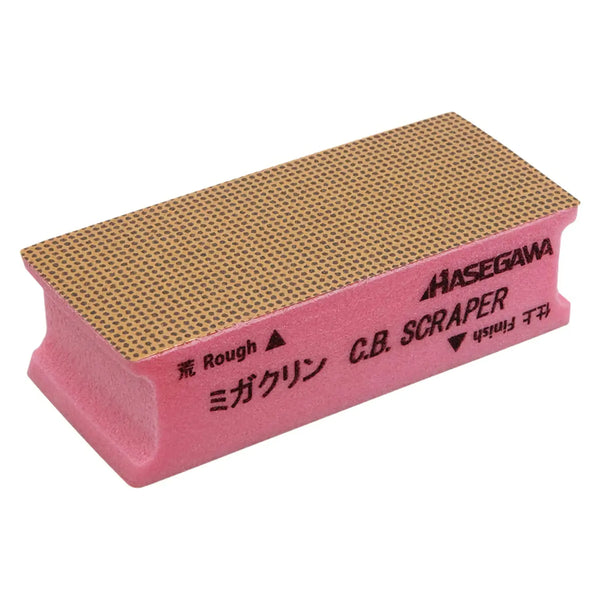The products we used:

Parker Asahi Cookin' Cut Synthetic Rubber Antibacterial Cutting Board Black
Click here for the product pageThe Common Kitchen Compromise

Cutting, chopping, dicing and slicing are serious business. Choosing the right cutting board is important because your cutting board is at the center of most of the cooking you do in the kitchen. If you're like me, you have three basic concerns when choosing one:
- Will it last a long time?
- Is it safe?
- Will the board and my knives get along?
Usually you have to make some compromise on one of these concerns.
If bacteria build up is a concern, plastic cutting boards are nice because you can bleach them. Your knives will be happy with a plastic board, too. However, plastic boards typically don't last very long. Plus, if they warp at all, then they become slippery and dangerous to use.
If properly maintained, a big, thick wooden cutting board will probably last a long time and the wood won't dull your knives, but what about bacteria build-up?
Glass cutting boards are safe from bacteria build up, and will last a long time, but your expensive knives will cry in pain every time you break out the onions. (And a dull knife isn't safe to use, anyway.)
And don't even get me started on bamboo.
Those aren't the only concerns, either. If you choose wood, you'll probably need to oil your board down once in a while, and you don't want to soak it in water or else you risk warping or discoloring it. Plastics can stain(I'm looking at you, tomato sauce), are at risk of melting, can absorb odors, and are ugly. Glass is more slippery, so wet food is harder to keep in place, making cutting more dangerous and stressful.
I've never been completely satisfied with the quality of my cutting boards. I usually just live with the compromise, and I imagine you do too.
But what if I told you that you don't have to live with it--that you don't have to compromise? What if I told you that there was a golden road to halleluya out of frown town?
A Tough, Safe, and Knife-friendly Cutting Board

The Cookin' Cut Cutting Board by Parker Asahi is a cutting board for professionals. Professionals have demanding needs.
- They can't waste money constantly buying new cutting boards.
- They can't make their patrons sick.
- They need their knives to stay sharp for as long as possible.
All the same pain points we kitchen enthusiasts have, they have them at scale.
Parker Asahi developed a cutting board to meet those needs and provide an uncompromising experience for professionals. The good news is that we enthusiasts can take the golden road, too.
So what is special about the Cookin' Cut?
Rubber, friends.
Tough, But With a Soft Side

The Asahi Cookin' Cut is made out of a synthetic, antibacterial rubber. The rubber is both hard and soft. It doesn't bend very easily in your hands, yet it bends around your knife's edge. Because of this simultaneous hard-and-soft nature, it feels like a normal cutting board, but it's much more resistant to cuts from even the sharpest knives.
For the same reason, the Cookin' Cut won't dull your expensive, sharp knives like a glass cutting board would.
Very impressive.
Quick-Drying
The Cookin' Cut's rubber material is resistant to liquid. Once you clean it, these bad boys dry out quickly. Bacteria won't have time to settle in before they're sent flying out into the ether.
Not only are Cookin' Cuts hygienic, easy on your knives, and cut resistant, they're heat and stain resistant, too.
What's The Catch?
I know, it seems too good to be true. This road must be gold-plated, right? Where are the potholes? Where are the grungy gas station stops along the way?
Let's talk maintenance.
An Easy Fix For Scratches and Stains

Although the Asahi Cookin' Cut is resistant to cuts and discoloration, it's not invincible. Long-term, you'll still get scratches. If you're busy and leave meat juice on the board for an extended period, it'll still leave a stain.
Additionally, although the Cookin' Cut's rubber material is hard and mostly inflexible, Parker Asahi warns that storing them upright could lead to bending or warping.
The good news is that cuts and stains on the Cookin' Cut can be easily buffed out with the Hasegawa Cutting Board Scraper or 100 grain sandpaper (Parker Asahi recommends sanding along the long side). You can scrape a few microns of material off the Cookin Cut and have a cutting board that looks like new. Nice.
The black version pictured in this article also suffers less from staining.
Otherwise, the Cookin' Cut requires no other maintenance.
Other Things to Keep In Mind: Washing
The Cookin' Cut is not dishwasher safe. Cleaning it in the dishwasher can cause permanent warping of the board. The good news is that it's safe to clean it with bleach or vinegar. Just don't soak it in bleach for too long.
Other Things to Keep In Mind: Heat Resistance
Although the Cookin' Cut is heat resistant, it's still possible to melt it. Keep it away from fire and don't place very hot pots on top of it. If you want to disinfect it with hot water, don't use water that's hotter than 194 degrees fahrenheit (90 degrees celsius). Be sure to treat both sides to prevent the board from warping.
Other Things to Keep In Mind: Does it flake?
If this is your first introduction to rubber cutting boards, some of you may be wondering if the synthetic rubber of the Cookin' Cut has any surprising properties. I know I was. For example, what happens when you swipe your knife along the face of the cutting board to pick up some onions? Are you going to have little bits of rubber in your food?
Ryky Tran addresses that concern and more in his long-term video review of the Parker Asahi Cookin' Cut. He says that it is possible to chip off material if you try, but under normal use he never noticed any cutting board material coming off.
Other Things to Keep In Mind: Slipping
Although the Asashi Cookin' Cut is made of rubber, it can slip if water gets under the board. That was surprising to me.
There are products for reducing slipping, such as the HASEGAWA Elastomer Resin Non-slip Mat (sold by Globalkitchen Japan, wink wink nudge nudge) for placing under your cutting board.
However, Ryky was dissatisfied with the Hasegawas and suggests a DIY solution. The Hasegawa mats often don't fit the exact dimensions of cutting boards (the black Cookin' Cut is available in 380x210 and 450x250, and the Hasegawa mat is available in 400x200 and 500x250), so food and moisture can often build up between the mat and the cutting board or between the mat and your kitchen counter. Instead, Ryky suggests buying rolls of silicon, cutting them to the exact dimensions of your cutting board, and placing the sheet of silicon under your cutting board.
If you DIY a perfectly fitting silicon mat, the results with Parker Asahi's Cookin' Cut are superior. But, if you aren't interested in taking a trip to the hardware store and getting your hands dirty, and if you don't mind the downsides of the Hasegawa mat, it is probably a good investment. And, of course, you can always try cutting the Hasegawa down to the right size and save some money on the silicon
Personally, I'd try using the Parker Asahi boards with a mat first, and then if I encountered slipping, I'd consider my options.
Final Thoughts

You hear that, friends? That's the sound of angels singing. Majestic. Powerful. Transcendant. The road to halleluya is paved with rubber, it seems.
However, getting to halleluya ain't cheap. The black Cookin' Cut pictured in this article is several times more expensive than similar wooden or plastic boards. Is it worth the price? Ultimately, that's up to you. If you have expensive knives that you want to keep as sharp as possible, or if you just want an aesthetically pleasing cutting board that's easy to care for and will last a long time, then the Parker Asahi Cookin’ Cut may be worth it to you.
The products we used:

Parker Asahi Cookin' Cut Synthetic Rubber Antibacterial Cutting Board Black
Click here for the product page













